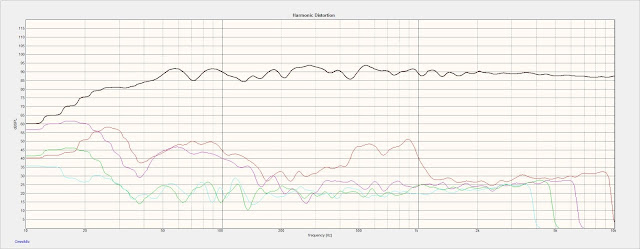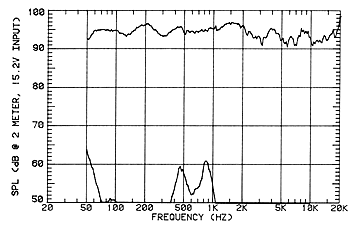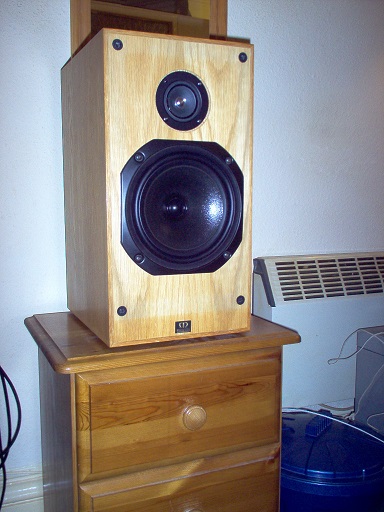Hi Everyone,
Has anyone had a chance to measured the ScanSpeak 6.5 Illuminator and/or Revelators for distortion recently?
Best,
Erik
Hello,
My measurement of 18W8531 revelator also shows humps of H2 around 500 and 850 Hz,
even at low acoustic levels ( around 85 dB / 1m ) witch cant be seen in Zaph's measurements.
crd
An externally hosted image should be here but it was not working when we last tested it.
Is that the actual woofer used on Beo90?
Reports say that with 3 woofers it had the best bass in the house at CES.
No, B&O uses the smaller Illuminator (12mu) mids as, mids...
The 18WU is often called a midbass in the Car Audio world and excels as a 2-way mid. The reason why I linked it is because of the nice explanation from Geoff about driver designs that have a nice Bl plateau designed in their motor and also in the suspension. Both Illuminators share that type of design.
12MU:
Source: B&O Tech: Why select one driver over another? (Part 1) earfluff and eyecandy
18WU:
Bl curve
Suspension curve
Source: http://medleysmusings.com/ss18wu4741/
The reason for that is explained in the article I linked. It also explains the dedication of a firm like Scan Speak to put real meaning into terms like X-max!
I'm sure the Klippel site has even more background on that for those interested.
The woofers are a bit bigger on the B&O 😉.
Attachments
That's unfair. The BeoLab is growing on me. I just saw the price of caskets. It might be cheaper to buy a single Beolab 90 so they can bury me in it.
Erik
I've got that part covered already... I will be cremated and my ashes will be put in my line arrays, hoping it will work a bit like the charcoal in Kef's research: KEF Innovation - ACE - KEF United States 😛 I only need to figure out the activating part...
I've got that part covered already... I will be cremated and my ashes will be put in my line arrays, hoping it will work a bit like the charcoal in Kef's research: KEF Innovation - ACE - KEF United States 😛 I only need to figure out the activating part...
I have this image of those line arrays decaying, so decades from now when the surrounds have rotted your ashes come spewing out in the middle of a Metallica riff to whoever was listening, causing them to be haunted.
hahaha. 🙂
Erik
Hello,
My measurement of 18W8531 revelator also shows humps of H2 around 500 and 850 Hz,
even at low acoustic levels ( around 85 dB / 1m ) witch cant be seen in Zaph's measurements.
crd

Awesome! Thanks. 🙂
Erik
I have just finished making a pair of Illumina 66 speakers designed by Troels Gravesen (in system pictures) which use the Illuminator 18WU/4741T00 and D3004/660000 which sound pretty good to me......I would say that having made them. I have not got any test equipment to analyze them with but I am not in a hurry to replace them. I wish I knew more about the design of crossover and speakers but sadly I am good at making but completely out of my depth with electronics.
Interesting discussion all the same.
Interesting discussion all the same.
Hi SteveT2!
There's no doubt that the Revelator and Illuminator have a very good reputation backed up by many user's experience. The reason for this discussion was that I just wanted a better comparison of the Revelator vs. Illuminator. In part because Zaph asserts the Revelator to be a better driver at 6.5" so the 30% price difference was not justified, however the distortion figures from the users here seem to say otherwise. This is my form of "bargain hunting."
If I can get better than an Illuminator for $100 less, of course I'll have to buy it! 🙂
Have you had a chance to compare the sound to a pair of Revelators?
Best,
Erik
There's no doubt that the Revelator and Illuminator have a very good reputation backed up by many user's experience. The reason for this discussion was that I just wanted a better comparison of the Revelator vs. Illuminator. In part because Zaph asserts the Revelator to be a better driver at 6.5" so the 30% price difference was not justified, however the distortion figures from the users here seem to say otherwise. This is my form of "bargain hunting."
If I can get better than an Illuminator for $100 less, of course I'll have to buy it! 🙂
Have you had a chance to compare the sound to a pair of Revelators?
Best,
Erik
Last edited:
eriksquires,
Get Illuminator next time or B&O : )
That said will still mean because Zaph can do a little better that if you want it as his ZRT in 500-1kHz area then do some smaller investigation job on your build, below picture is yours then Zaph ZRT then jmbee, of course there is no guarantee to get it same, but some patience as wesayso showed when build his LA probably helps.
Difference could very well be acoustic area around woofer that Zaph has better on ZRT, try different stuffing and density materials behind driver also such as tighten mounting screws or loose them, or try a decoupling basket. Probably zoomed in impedance measurements would help alot and show some clues for every new mod one do.
As add to wesayso's 12MU post saw T. Graversen also have a good eye on that driver, see specific text under picture with the drivers inside cardboard box Illuminator-5.
Get Illuminator next time or B&O : )
That said will still mean because Zaph can do a little better that if you want it as his ZRT in 500-1kHz area then do some smaller investigation job on your build, below picture is yours then Zaph ZRT then jmbee, of course there is no guarantee to get it same, but some patience as wesayso showed when build his LA probably helps.
Difference could very well be acoustic area around woofer that Zaph has better on ZRT, try different stuffing and density materials behind driver also such as tighten mounting screws or loose them, or try a decoupling basket. Probably zoomed in impedance measurements would help alot and show some clues for every new mod one do.
As add to wesayso's 12MU post saw T. Graversen also have a good eye on that driver, see specific text under picture with the drivers inside cardboard box Illuminator-5.
Attachments
So, you have something against soft domes? Dome tweeters? Dome midranges?
Whoa, imagine that - you seem to know quite a bit about speakers, yet you seem to be using an old paper cone tweeter one might expect to pick out of some discarded speakers tossed on the rubbish pile?
So I better also say, I'm not jumping in here to criticize you, the purpose of my statement above was merely to illustrate my surprise. Now I need to explain why I took profound notice of your tweeters:
I haven't really enjoyed listening to music very much ever since my old cheap speakers got lost one time when I was moving (out of a not very good neighborhood - I think maybe somebody grabbed them and ran off?) - anyway, those speakers also had paper cone tweeters with aluminum dust caps. They were two-way "bookshelf" speakers with an 8" paper cone woofer (and the above mentioned tweeter). The brand was "db", the cabinets were cheap and light particle board and the were vented with a cardboard tube as the port.
If I try to listen to some $10,000 B&W speakers in an audio boutique, I get a headache and need to leave before long due to "listening fatigue". I could listen to my cheap old speakers all day, or two days, whatever, just fun and pleasing to hear (driven by a tube amp playing vinyl records).
Whoa, imagine that - you seem to know quite a bit about speakers, yet you seem to be using an old paper cone tweeter one might expect to pick out of some discarded speakers tossed on the rubbish pile?
So I better also say, I'm not jumping in here to criticize you, the purpose of my statement above was merely to illustrate my surprise. Now I need to explain why I took profound notice of your tweeters:
I haven't really enjoyed listening to music very much ever since my old cheap speakers got lost one time when I was moving (out of a not very good neighborhood - I think maybe somebody grabbed them and ran off?) - anyway, those speakers also had paper cone tweeters with aluminum dust caps. They were two-way "bookshelf" speakers with an 8" paper cone woofer (and the above mentioned tweeter). The brand was "db", the cabinets were cheap and light particle board and the were vented with a cardboard tube as the port.
If I try to listen to some $10,000 B&W speakers in an audio boutique, I get a headache and need to leave before long due to "listening fatigue". I could listen to my cheap old speakers all day, or two days, whatever, just fun and pleasing to hear (driven by a tube amp playing vinyl records).
Hi Everyone,
When choosing between the 6.5" ScanSpeak Illuminator and Revelator I went with the Revelator in large part due to the comments Zaph made about the Revelator having lower distortion than the Illuminator.
Even though I wasn't really focused on measuring the Revelator, I did measure distortion recently, while doing more extensive measurements on a tweeter. One thing that came up was some distortion pops up in the upper end of the Revelators I wasn't expecting here, between 500Hz and 1kHz (ignore DB values!):

The same distortion shows up without a crossover by the way. Since Zaph clearly has a lot more experience I was tempted to discount my measurements until I saw the same distortion pop up in another measurement set. Thanks to a review by SoundStage Network and the National Research Council of Canada's measurements of a Wilson Sophia which includes the same driver:

Addmitedly, Zaph mentions not to use his measurements without duplicating his methods, but his old charts are perfectly flat distortion wise. I'm wondering if the Revelator has changed, or if Zaph's measurements somehow missed this, or if maybe he accidentally reversed the data for the Illuminator and Revelator?
Has anyone had a chance to measured the ScanSpeak 6.5 Illuminator and/or Revelators for distortion recently?
Best,
Erik
Here are few links that have solid measurements of 18W/4531 and 18W/8531:
http://www.audiocomponents.nl/download/scan-speak/18W-4531G00 - Hobby HiFi 2003-3.pdf
http://www.audiocomponents.nl/download/scan-speak/18W-8531G00 - Hobby HiFi 2002-3.pdf
First thing i must say is that you have good measuring equipment 🙂
Second thing - i don't think that guys in Scan Speak worry that much about 2nd order HD. It is not yet proven that it is detectable and what levels of it are detectable while listening. Who determined 1% od total THD as the treshold of hearing it ? Floyd Toole mentiones more like 4% THD and that is highly dependant of which order of HD contributes the most to THD. Mainly it is considered that 3rd and 5th HD contributes the most to the unpleasant sound of the loudspeakers, and from what i can see from lots of measurements, they are exceptionally low in Revelator series. 2nd and 4th HD are marked like pleasant or undetectable by ear (at least at levels that they contribute to the overall sound that we find in modern loudspeakers).
Same goes for 15W/8530. Zaph too often states the importance of THD but then builds the loudspeaker ZD5 and comments it as:
"This is without a doubt the best sounding 5" 2-way I've designed. I won't be so bold and arrogant to say this is the best 5" 2-way in the world, but I will say that I've seen enough overpriced speakers that just don't sound as good as their price might suggest mainly due to under performing drivers and poor design decisions..... If you're after high performance music reproduction that is very uncolored and true to the original recording... and you have a few extra bucks to spend, you might consider this design."
These are the measurements of 15W:
http://www.audiocomponents.nl/download/scan-speak/15W-8530K00 - Hobby HiFi 2003-4.pdf
So, from all this i would conclude that you shouldn't worry much about THD as long the biggest component of it is 2nd HD and your 2nd HD being 1.5% and if your music sounds right 🙂
Last edited:
That's really good perspective Zvu, have you had a chance to compare the Revelator vs. Illuminator subjectively?
Best,
Erik
Best,
Erik
To compare them (properly) would mean to me that i should have listened two loudspeakers designed by one designer and with same design goals - in other words, two way loudspeaker with similar xover point but one with revelator, other with illuminator in it. That i did not do. But i listened 15w Revelator and there is nothing wrong with it - at least to my ears.
That being said i can't seem to remember i have ever heard anyone complaining about bad sound out of their revelators.
So, i would suggest (if i may) that you don't change anything untill you listen to illumina in your system verifying for yourself that difference in cost is justified.
That being said i can't seem to remember i have ever heard anyone complaining about bad sound out of their revelators.
So, i would suggest (if i may) that you don't change anything untill you listen to illumina in your system verifying for yourself that difference in cost is justified.
My only concern is that you wouldn't be able to decide which one to keep so you might end up with two pair of speakers 🙂
It's funny. Speakers or cats. Whenever more appear in my house there's less money in my bank account. Why is the correlation so strong?
Erik
Erik
Some news from Scan Speak:
Scan-Speak
New 18cm Revelator Midrange - 18M/4631T00.
Scan-Speak
An externally hosted image should be here but it was not working when we last tested it.
New 18cm Revelator Midrange - 18M/4631T00.
That's a really nice looking driver, and it looks like they even got their Fs to match their graph this time. 😉 The calculated box volume for a sealed box is very large for a midrange though, 1.27ft3/14 lts. That it's this large tells me the figure are probably accurate, unlike the woofer specs which never matched with recommended volumes or their own impedance charts. I'm better off using the G version as a midrange. I get lower extension in a smaller box. Am I missing something besides the better HF response? This would be much more attractive if the Vas was about half.
Of course, this also means that the BeoLab is already using outdated driver technology.... hahahahah. 🙂
Best,
Erik
Last edited:
What a great site but it took like 10 minutes for me to load the page. ;-)
Thanks for the data, it looks a lot like mine.
Best,
Erik
- Status
- Not open for further replies.
- Home
- Loudspeakers
- Multi-Way
- ScanSpeak 6.5" Revelator vs. Illuminator Distortion Revisit




